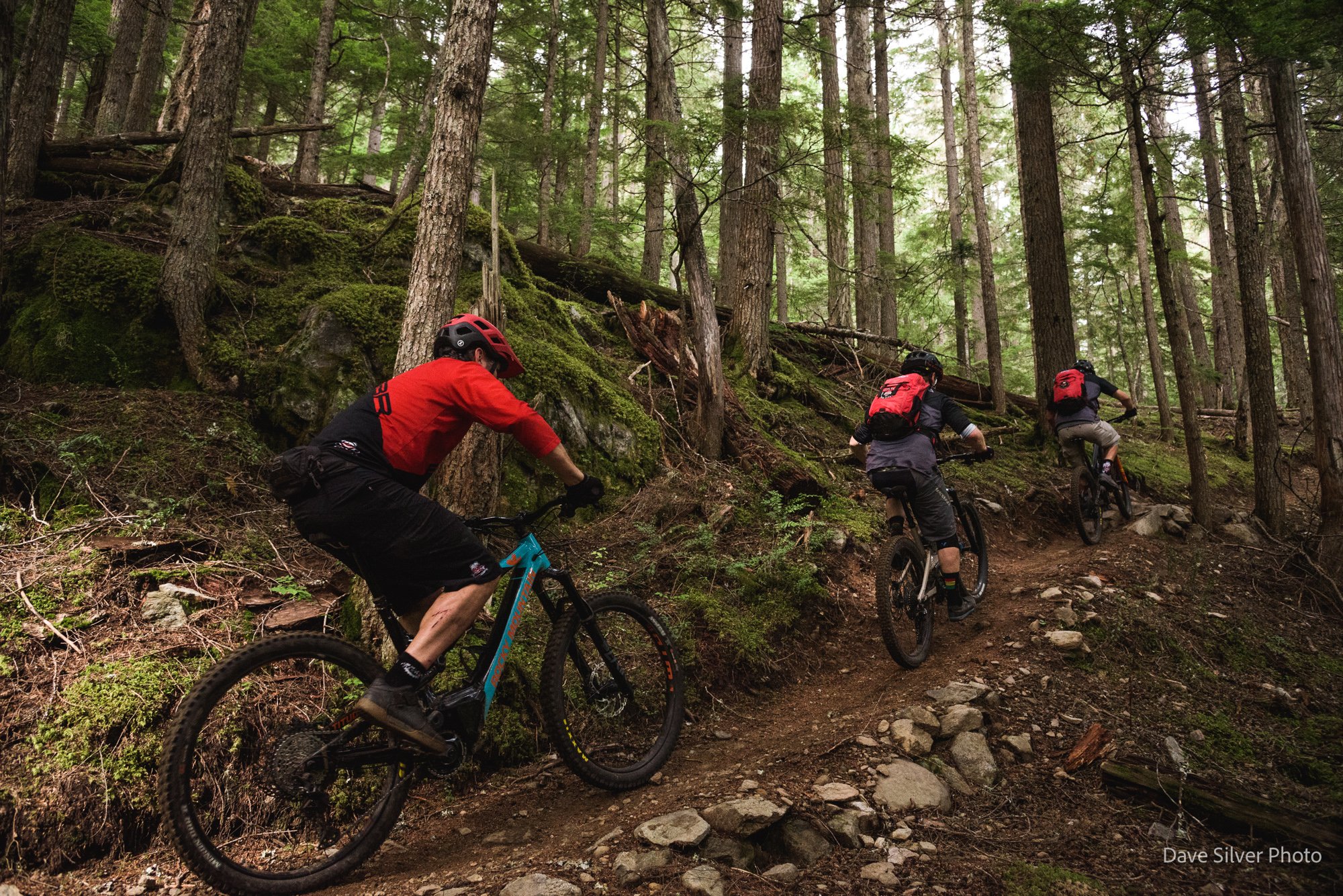Getting ahead of the electric buzz
A working group hopes to tame the wild west of electric recreation on mountain bike trails
The buzz on the trails around Whistler is growing louder. It’s not the opening of a new trail or the launch of a new lift. It’s the sound of more electric bikes. And it’s not just in Whistler: it’s across the province and around the world.
Every day more mountain bikers trade in pedal power for electric-assist bikes. The shift is creating conflicts on Whistler’s 50 kilometre, paved Valley Trail network. Martin Pardoe, the Resort Municipality of Whistler’s manager of parks planning, knows it won’t be long before they start having issues on the area’s world famous mountain bike trails, too.
“We’re very much aware of a changing landscape of e-mobility devices,” says Pardoe. “We thought we should start to get ahead of it.”
In general the availability of electric mountain bikes is a good thing. A boost of power allows more people, including people with physical disabilities and the elderly, to access more trails. A more accessible sport means more people caring about the sustainability of nature, trails and mountain biking.
However, the booming electrification of recreation, combined with opaque and contradictory rules, a lack of enforcement, and ignorance are bunching up like the peloton before a tight turn. Stewards of non-motorized trails, in B.C. and around the world, worry that overpowered bikes will increase trail maintenance, cause more user conflicts, create insurance concerns and lead to even more powerful bikes on trails.
Whistler is one of the first B.C. municipalities to tackle the e-revolution and others are watching carefully. How the mountain bike community navigates the next few years will determine whether the upcoming corner crashes the peloton, and leaves lasting damage to mountain biking, or everyone works together and emerges ready to tackle the next challenge.
“There’s a lot of confusion, which makes it quite concerning to the future of mountain biking,” says Martin Littlejohn, the executive director of Mountain Bike BC, which promotes the sport in the province. “We want everyone to be able to keep riding, so we want to help all mountain bikers, electric or not, be responsible users of the trail.”
There are two sets of provincial rules that govern the use of electric bikes.
In 2019, Recreation Sites and Trails BC and BC Parks, adopted an off-road e-bike policy. It was an adaptation of the U.S. e-bike classification system and allowed Class 1 e-bikes on most non-motorized trails. Class 1 bikes have a maximum speed of 32 kilometres per hour, a motor with a maximum average power output of 500 watts, and are pedal-assist, meaning the motor only engages while the rider is pedaling. These rules were due for revision every three years, but six years later, have still not been updated.
More recently the BC Ministry of Transportation and Transit (MOTT) created its own rules under the Motor Vehicle Act for what differentiates an e-bike and an electric motor-bike on roads and bike lanes. Motor bikes require a license plate and drivers license and aren't allowed in bike lanes. MOTT went with Class 2 e-bikes as the limit, so that utility bikes with multiple seats and cargo areas would be allowed. Class 2 still caps the speed at 32 kilometres per hour and “maximum continuous wattage output of 500 watts”, but allows a throttle, which means pedalling is optional.
Up until recently e-mountain bike manufacturers were happy to comply with the off-road e-bike Class 1 parameters. But as the e-bike market grew, business became more competitive. New entrants into the market began to blur the classes, selling bikes with throttles or higher levels of average power and calling them mountain bikes.
Others, in particular Surron, ignored the classes altogether. It describes its Light Bee X model as “Part dirt bike. Part MTB. All electric.” It has 8,000 watts of power and can travel 75 kilometres per hour. It’s not licensable in B.C.
Most people in the bike industry agree there’s no place for Surron-type bikes on non-motorized trails and streets. But many of these e-dirt bikes are available direct-to-consumer, which leaves it up to customers to learn where they are allowed to use their new toy. Many land managers and municipalities are starting to push back, says a Singletracks article. People for Bikes, a U.S. advocacy group, is publishing a series of articles highlighting the differences between e-bikes and e-motorcycles. Last summer North Vancouver RCMP highlighted that “e-dirt bikes are not street legal” and increased enforcement, including a $598 fine.
It’s tougher to enforce e-bike violations on non-motorized trail networks and at bike parks. Reports of people using Surron-type bikes at both are increasing, says Littlejohn.
“These are dirt bikes and should only be ridden on sanctioned motorized dirt bike trails,” he says.
But even if Surrons aren’t mountain bikes they influence the industry by encouraging power creep. When watts and Newton metres, a measure of force, are the gauge of performance, increasing those numbers is how brands show they are leading innovators. With e-bikes they can often make the adjustment remotely with a software update. For instance, one well known bike brand recently released a firmware update for its e-mountain bike platform that increased max power from 500 watts to 700 watts and torque from 65 to 75 Nm. Anyone that owns an older model can install the update and realize the extra power and force. That means the motors always had these capabilities, but were limited by software. Future updates could extend the power further.
Now Amflow is pushing the limits to another level. The e-mountain bike, from the makers of DJI drones and action sport cameras, maxes out at 1,000 watts and 120 Nm. In the competitive e-bike market other brands are likely to follow with equally powerful rigs of their own. Already several other mountain bike brands have released models equipped with motors that exceed the class 1 restrictions.
Users are warned that they are exceeding Class 1 limits when they adjust the Amflow to its higher power outputs. Other brands stay within the Class 1 rating, and thus trail legal (where allowed), by keeping the bike’s “average” power output under 500 watts. Proponents of the power upgrade point out that top mountain bike racers can hit 750 watts without any power assist.
However, experts say this is a slippery downhill. Max wattage and torque matter more than the average watts for trail sustainability, says Rocky Blondin, an electric power expert and mountain bike trail builder.
To understand why, he says to think of torque as the motor’s ability to “push” the bike uphill, while power is the speed at which it can do the pushing. High watts combined with the added Newton metres will make it more likely these e-bikes will spin out, causing more erosion. Trail managers in popular zones for e-mountain bikes are already starting to see the effects, mostly rutted corners on climbing trails, a phenomenon rarely seen with pedal bikes and lower powered e-bikes. Traveling at higher speeds, e-bikes are also more likely to cut corners and increase the chances of negative encounters with other trail users and wildlife.
There’s enough confusion with all the different variables and rules that many cyclists don’t know what they’re riding or what they’re allowed to do with it. When Whistler surveyed e-bike riders and asked what their max speed was, a surprising majority didn’t know, says Martin Pardoe.
That raises liability concerns. Acera Insurance, a broker that insures most of the mountain bike clubs in the province, says e-mountain bikes are allowed at club races and events as long as they are within the Class 1 rating and have a different start time than pedal bikes. What happens when e-bikes exceed the Class 1 rating, but the riders or clubs don’t know it? That remains to be tested.
It’s all a bit like riding in the dark. The light, says Martin Littlejohn, is clear guidelines and rider information. He would like everyone–the public, clubs, retailers, manufacturers and regulators–to work together to update policies and information on e-bike classifications to make it much clearer where the different classes of e-bikes and e-motos are permitted. He has assembled a working group, including ORCBC, Recreation Sites and Trails, BC Parks, and representatives from industry and clubs, to begin the process.
They won’t be reinventing the wheel. IMBA USA has a dedicated page on its website to e-bike etiquette. And mountain biking has worked on similar projects in the past. Clear definitions, rules and education has worked for encouraging dirt bikers to stay off non-motorized trails. On mountain bike trail networks with strong social pressure dirt bikers know they are not welcome and don’t bother riding there.
The complexities and nuances of electric bikes and dirt bikes will make it more challenging, but simple signage will help. For that Littlejohn is looking to Whistler where Martin Pardoe is beginning an e-bike education campaign.
The Resort Municipality is installing 230 “etiquette, respect and safety” signs across the paved path network. At mountain bike trailheads and junctions they will install a different set of signs designed to get mountain bikers to stop and think. A draft version asks, “Is your e-bike allowed on the mountain bike trails?” Below, the sign splits in two. On the No side are electric motorbikes, e-bikes with more than 500 watts of power, and bikes with throttles. On the Yes side are pedal-assist bikes with less than 500 watts of power. A sidebar notes adaptive e-bikes are permitted.
It puts the decision on the handlebars of riders–right where it belongs.
It’s not a perfect remedy to the increasingly complex challenge of electric recreation. But if nothing else it will generate conversation about the future of mountain biking and that’s always a good kind of buzz to hear on B.C.’s trails.


